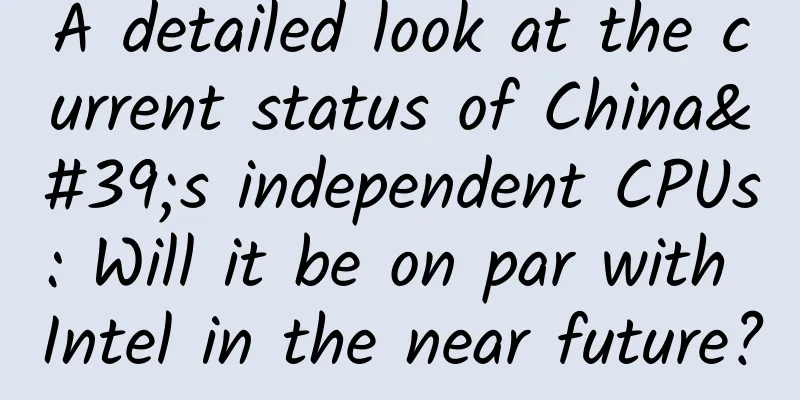A detailed look at the current status of China's independent CPUs: Will it be on par with Intel in the near future?

|
It will take some time for the ZEN processor to be released. The current desktop CPU market is really boring. Since foreign products are not good enough, let’s talk about domestic CPUs! Although domestic CPUs are basically unused, they are well-known. First there was the top supercomputer Tianhe, and then there was the self-developed CPU Loongson. In addition, there are many domestic CPUs with their own characteristics. Let's take a look at what self-developed domestic CPUs are: 1. Loongson - a pure-blooded domestic CPU Loongson is honestly not the earliest domestic CPU, nor the most successful, but it has the highest popularity. Various TV news reports show that it was born in the Chinese Academy of Sciences and has a pure bloodline. It has become a representative product of domestic CPUs. From a computing perspective, Loongson is indeed a relatively pure domestic CPU, but the instruction set is still not self-created. It uses the MIPS instruction set and has developed its own set of specifications on this basis. Dr. Hu Weiwu, the father of Loongson, said that the CPU can be made the best in the world, but the instruction set is different and the software cannot be used. Users will definitely not buy it. It costs a lot to build its own software ecosystem. Loongson had no choice but to choose the MIPS instruction set, which had a good foundation in universities and scientific research institutions at the time. Although the instruction set is someone else's, under the development of Loongson, more than 500 custom instructions have been added, and the computing efficiency has been greatly improved. The latest Loongson 3A3000 single-thread performance is about one-third of Intel I5 4460. Although it is said on paper, Loongson has almost no application support. It is just a bare commander. The parameters alone have no reference significance. It is not very scientific to expect Loongson to perform well in the desktop market. However, there is a lot of room for development in the military and aerospace fields. The Beidou twin satellites launched in 2015 are equipped with Loongson. The performance and price are far better than imported aerospace CPUs. The subsequent national defense and aerospace fields will be equipped with domestic CPUs. I believe this will be the correct development path for domestic U. 2. Shenwei/Feitian - the most successful representative with military background The above Loongson is a military industry from the Chinese Academy of Sciences, while Shenwei and Feiteng are the sons of military research facilities. Compared with Loongson, it is more natural to take on the task of manufacturing domestic military CPUs. In terms of instruction set, Shenwei processors use the Alpha architecture, while Feiteng, after several rounds of changes, finally chose the ARM V8 instruction set. Loongson still has well-known products in the desktop market, while Shenwei focuses on the supercomputing field. Its Shenwei Taihu Light also broke the six consecutive championships of "Tianhe-2" and became the world's number one supercomputer. Shenwei uses the CPU SW26010, 260 cores, Alpha 64-bit architecture, and its performance is almost three times that of Tianhe-2, but the total power consumption is lower. Feiteng processors using the AMR architecture are making efforts in the server CPU field. Its "Mars" server CPU has full chip performance comparable to Intel Xeon E5-2699v3. It was a copycat of Intel in the early years, but now it can compete with its big brother, which is rare. 3. Zhaoxin/Haiguang—late-stage newcomers driven by policies The domestic U mentioned above has a problem, that is, it does not support WINDOWS. If you want to quickly develop a commercial CPU, you still have to go the X86 route. But this is Intel's bread and butter, and it is basically impossible to obtain its authorization. What can you do? At this time, an old man in the family is like a treasure. Domestic manufacturers have successfully hooked up with the dying Taiwan VIA. Although VIA is only a shell, it still has X86 patents. Faced with the high salary of the mainland, they are naturally willing to cooperate with the mainland. Zhaoxin was established in 2013 by Lianhe Investment under the Shanghai State-owned Assets Supervision and Administration Commission and VIA. Shanghai invested 80% and VIA held 20%. To put it bluntly, the mainland provided the money and VIA provided the technology. The current products have nothing to do with independent development (except the name). To put it bluntly, they are OEMs. The performance of VIA Nano, which has not been updated for ten years, can be seen in the figure below: The performance is very poor. It can also be seen that as long as it is developed honestly, technology blockades are not a problem at all, and it can reach the international level. However, why can such an obviously OEM U be called a Chinese chip? The reason lies in the national policy - " core high-tech basic ". According to public reports, Zhaoxin has received a subsidy of 5.6 billion for the core high-tech basic, and is still applying for a total of 7 billion. To be honest, even if Zhaoxin does not do its job in the future, it will not have to worry about food and drink in the next five years. Here the government has committed the taboo of rushing for success. The domestically developed Us in previous years have achieved little results. In order to accelerate development, the government has recognized enterprises that have introduced technology, thus creating such a "Chinese chip" that has no autonomy at all. It is said that VIA is short of money, but in fact AMD is also short of money. So this year AMD also authorized X86 to a Chinese company, and the authorized company is Tianjin Haiguang. AMD received a licensing fee of 293 million US dollars, and the two parties will also establish a joint venture. Even if a joint venture is established, the products in the past few years are still mainly AMD's vest U, but at least AMD technology is available, unlike VIA Zhaoxin, which has such a low starting point. Whether domestic companies can master AMD technology will take time to verify. 4. HiSilicon - the leader of private chip companies Huawei's HiSilicon is familiar to everyone. Compared with the previous products that can't be touched, HiSilicon's processors are used by everyone every day. In addition to HiSilicon, there are also a number of private chip companies such as Spreadtrum, Allwinner, and Rockchip. They don't have a big background. Except for HiSilicon, which is backed by Huawei, the other achievements are completely achieved by their own hard work, and the progress is also very great. For businessmen, survival is the bottom line. With the market as the guide, they choose the most popular ARM architecture. Although they were all OEM in the early stage, after several generations of development, the latest HiSilicon Kirin 960 has reached the international top level. At the same time, the high premium of Huawei products also leaves sufficient profit space for HiSilicon. The above are all companies that can produce products. In addition, there are Macrochip, which has obtained the IBM Power architecture license, Ingenic, which has obtained the MIPS license, and Beida Zhizhi, which has obtained the X86 license. However, their products are more on the PPT or display stand, and they are still a little short of being singled out. Advantages and disadvantages of each architecture: MIPS: The "academic school" represents the instruction system chosen by Loongson. Although it is not a self-created instruction set, Loongson's development over the years has completely surpassed the scope of MIPS. It can be regarded as Loongson's own thing, which is the best in terms of autonomy. However, the current software industry's support for the MIPS system is extremely weak. Even though Loongson has been actively building its own software ecosystem for many years, with more than 200 downstream supporting companies, the survival environment is still difficult. If the country really decides to use Loongson products, it is likely to spend unprecedented funds to deploy the software ecosystem. Alpha: The instruction system chosen by the "military faction" on behalf of Shenwei. Since most of the patents related to Alpha have passed the protection period, Shenwei can use it freely and its autonomy is also greatly guaranteed. However, the disadvantage is still the same as the Loongson mentioned above, with extremely lack of software support. Fortunately, Shenwei is taking the supercomputing route and is not in a hurry to enter the mainstream market. ARM: The favorite instruction system of the "private faction". Its products are widely used in smartphones and mobile devices. At the same time, the ARM architecture system is mature, with rich software support, easy to develop finished products and achieve profitability, and less dependent on national financial support. In the case of X86 dominating the mainstream market, ARM is currently the most powerful competitor with broad market prospects. The disadvantage is that domestic companies need to purchase licenses from ARM regularly, and the core technology is still in ARM. Domestic companies lack autonomy, and security is out of the question. x86: It can be said to be the favorite instruction set of the "state-owned capital faction". It can be used right away, and it can also be used as a national project foundation, which is also very good. X86 is the most useful, but it is also the most complicated. Long-term use is likely to be strangled by the licensee. According to the current situation, the two X86 licensees are facing different difficulties. The opening of technology to China will be further improved. Considering the current domestic situation, cooperating to develop products that meet the government's information security needs is the most realistic development path for "China Chip". The future of "China Chip" In the current technological environment, establishing a new standard is a very difficult road. According to the spirit of seeking truth from facts, cooperating with foreign countries to develop X86 processors that meet security needs is a more realistic approach at present. At the same time, the government should also support the development of truly independent CPUs, such as Loongson and Shenwei. Even if the current software support is very fragile, the ultimate hope of "China Chip" still lies in them.As a winner of Toutiao's Qingyun Plan and Baijiahao's Bai+ Plan, the 2019 Baidu Digital Author of the Year, the Baijiahao's Most Popular Author in the Technology Field, the 2019 Sogou Technology and Culture Author, and the 2021 Baijiahao Quarterly Influential Creator, he has won many awards, including the 2013 Sohu Best Industry Media Person, the 2015 China New Media Entrepreneurship Competition Beijing Third Place, the 2015 Guangmang Experience Award, the 2015 China New Media Entrepreneurship Competition Finals Third Place, and the 2018 Baidu Dynamic Annual Powerful Celebrity. |
<<: Experts reveal: Playing with your phone while charging isn't that scary
>>: Will the next iPhone have an OLED screen? This Japanese company is the key
Recommend
Third-hand smoke is everywhere
When you walk into a private room in a hotel, you...
Financial management product launch tips: Why not worry about short-term channel costs?
With the listing of Internet financial platforms ...
Introduction to the process of building Toutiao information flow ads
Pre-advertising preparation 1. Open an account. W...
Why do Android devices become stuck after being used for a long time and Apple devices crash after being used for a long time?
Generally, after using a mobile phone for about t...
[Discussion with Prizes] Aiti Tribe Topic Exchange Activity
[51CTO.com original article] Dear friends, the 51...
Is Miaopai's efforts in vertical content a desperate gamble or a confident move?
Vertical short videos are the first choice for sh...
Zheng Chuanhua, the customer-attracting master, will give you a full course of "Million Customer Flow Explosion Camp" in 2021
Introduction to the full set of course resources ...
High temperature and thunderstorms cause flight delays, here is a summer flight attendant safety guide →
Since the beginning of summer, many areas in nort...
What are the most effective APP promotion channels at present?
What exactly is APP promotion for? Is it a channe...
HTC makes a comeback, and the spy photos of the tablet with a design similar to HTC One are exposed
[September 10 news] There were rumors that HTC wil...
Just 10 minutes a day! This simple exercise keeps you away from cancer and cardiovascular disease!
Just 10 minutes of exercise can increase the numb...
What are the functions of Foshan lawyer mini program development and how much does it cost to develop a lawyer legal consultation mini program?
Recently a friend consulted me and wanted to make...
B station’s method of attracting new users!
The reason for dissecting this activity is that I...
Example explanation: B-side TV advertising
Based on his actual work experience, the author o...
Whispering Community Pinduoduo VIP Member Series - Super Detailed Pinduoduo Practical Operation Strategy
The course content includes 8 short courses for be...









